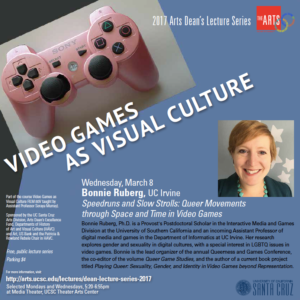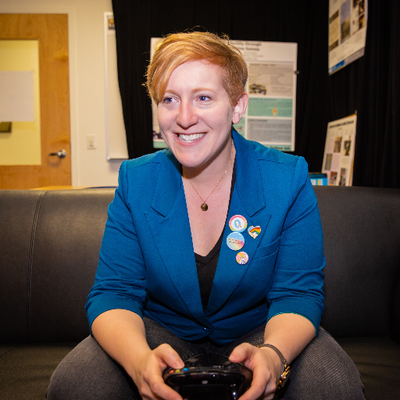 I’m honored to say that I’ve been invited to give a guest talk in the Art Dean’s Lecture series at UC Santa Cruz in a few weeks as part of Professor Soraya Murray’s class “Video Games as Visual Culture.” Santa Cruz, here I come!
I’m honored to say that I’ve been invited to give a guest talk in the Art Dean’s Lecture series at UC Santa Cruz in a few weeks as part of Professor Soraya Murray’s class “Video Games as Visual Culture.” Santa Cruz, here I come!
Soraya has lined up an amazing roster of speakers, including folks like my friends and colleagues Alenda Chang, TreaAndrea Russworm, and Aaron Trammell. I wish I could sit in on all the talks.
My lecture is adapted from a chapter of my monograph (under official review at NYU Press), Playing Queer: Sexuality, Gender, and Identity in Video Games beyond Representation. The talk is called “Speedruns and Slow Strolls: Queer Movements through Space and Time in Video Games,” and it looks at how player practices and design can enact queerness by playing with temporality. Here’s an excerpt:
Over the past decade, queer time has been a focus in the work of theorists like Jack Halberstam, Heather Love, and Elizabeth Freeman. This work is founded on the idea that our concepts of temporality are social constructions, and that there is a deep relationship between heteronormativity – the straight, “normal” way of being — and time. Freeman calls this “chrononormativity” – the idea that we are supposed to live according to a “coordinated, carefully syncopated tempo” of life events, many of which are ties to gender and sexuality… Queerness does time differently…
Chrononormativity can also be found in video games. The medium of video games has its own standards for temporal and spatial progress: how long a certain type of game will take to play, how quickly a player is meant to pass through an area, etc. In the context of video games, chrononormativity names a set of foundational logics that have come to shape how games are designed and experienced. These logics are today so deeply engrained that they have become all but invisible…
When it comes to time and space in video games, speedrunning can be understood as a queer gameplay practice. This is because it rejects chrononormativity. By definition, speedrunners play faster than they are supposed to. Because they play so fast, speedrunners also stand in a queer relation to game space. They speed through areas that they are meant to be cautious or to explore. Speedrunners transform open game environments into race tracks. In this way, speedrunners set their own terms for what it means to exist in time and space within a video game…
The mechanisms of walking simulators can be directly tied to longer histories of queer figures in motion — like the flâneur. These parallels are far from coincidental. Like speedrunning, walking simulators disrupt the chrononormativity of video games. In The Queer Art of Failure, Halberstam writes that “inaction and passivity” can be recategorized as “weapons of the weak” that enact resistance by “stalling the business of the dominant.” Inherent in the use of the term “walking simulator” as an insult is the belief that these game are unacceptable because they are characterized by inaction and passivity. Yet, this is precisely what walking simulators do: they stall the business of the dominant…
You can read the full transcript of the talk here — or come on down to UCSC on Wednesday, March 8 and check it out for yourself!

